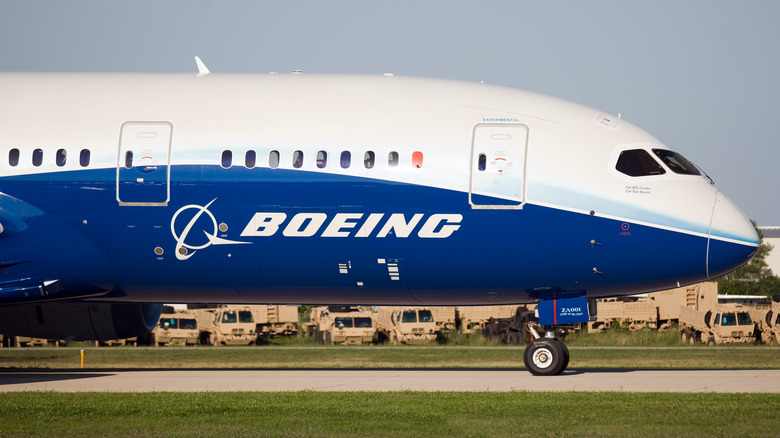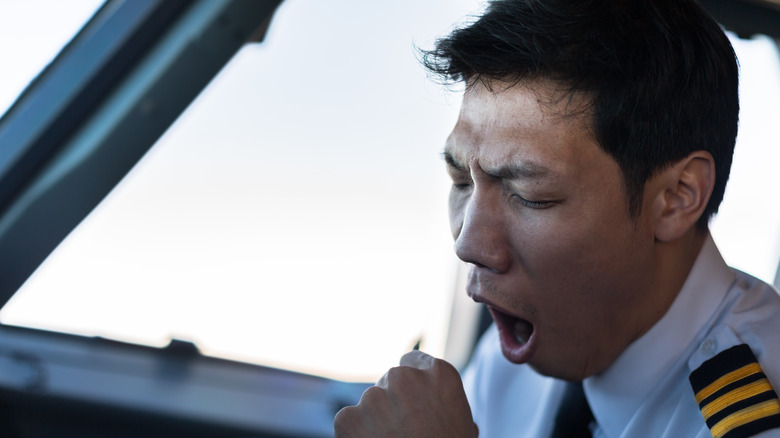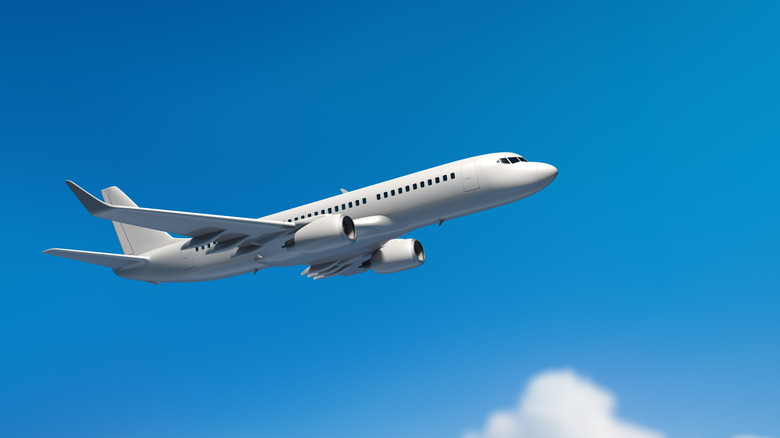The Secret Language Of Pilots You Didn't Even Know About
Every industry has its own jargon — a collection of technical terminology, slang, and miscellaneous other lingo that's typically unfamiliar to outsiders. With its high-level skills and a broad knowledge base that includes topics like aerodynamics and meteorology, the aviation industry soars above most when it comes to its jargon. Some phrases we're all familiar with, like "holding pattern" and "mayday," have even made their way into popular nomenclature. But sit down for drinks with a handful of pilots, and you may end up feeling a bit lost in the lingo.
Since Duolingo doesn't yet have a "pilotese" feature, we've compiled some under-the-radar pilot words we found lurking in chat rooms and on aviation industry websites. Whether your next flight through the friendly skies is on a jumbo jet, a prop plane, or a tiny puddle jumper, here's your Rosetta stone to the secret pilot language you might get to hear while in flight.
Air pocket
Those who find air travel just a tad frightening can take comfort in the fact that the laws of physics keep each plane aloft. As a plane's thrust moves it forward, the air moving over its wings creates a pressure differential, causing the craft to lift upward. When a plane encounters a wind current or change in pressure that interferes with that upward lift, sometimes causing it to drop momentarily, pilots refer to this as an "air pocket." Example: "That air pocket was a bit much for the new flight attendant."
All-Call
If you pay attention during your next flight, you'll likely hear this flight crew code word uttered by a flight attendant followed by a double ding sound. According to TikTokker, The Traveling Flight Attendant, this is simply a signal for flight attendants to report to their assigned door or other station. Example: "Cabin crew, cross-check and all-call."
Alley
Sometimes also referred to as the "alleyway," an alley is a space that falls between two jetways beyond the concourse slash gate area and the ramp where jets start their engines. There's only room for one jet there, and airplanes typically have to wait for their turn in the alley. Example: "We were almost in the alley but had to let another airline jump ahead."
Apron
Usually synonymous with "ramp," an apron is the essential spot next to the airport terminal where a plane is serviced, fueled, boarded, and loaded or unloaded. The domain of the ground crew, the apron, is where you'll see luggage getting transported on baggage carts. Example: "They were loading on a bitterly cold apron that morning."
Blue juice
Although it sounds a bit like a tropical drink that might come served with a slice of pineapple and a maraschino cherry, "blue juice" is not something you'd want to sip on. The term refers to the winterized blue chemical used for cleaning and deodorizing the airport lavatory, and it's actually a copyrighted product name. Example: "Can you tell the captain we need some more blue juice?"
BOEING
Back in the day, when Ford's reputation was a little rough, the brand's detractors would often poke fun at the name, joking that it stood for "found on road dead" or "fast only rolling downhill." Pilots have their own salty anagram thanks to Boeing's tanking safety record amid the 737 Max debacle: "Bits of engine in neighbor's garden." It's usually heard as a punchline after, "Well, you know why they called it BOEING, right?"
Boredom tube
Some pilots love flying for a big commercial airline. But it's not for everyone — especially the long-haul flights in large passenger jets. For those folks, the life of a commercial airline pilot is a life stuck in a "boredom tube." As a user in an Airline Pilot Central forum thread put it, "Flying is fun. Being stuck in a tube for hours to face a rotten hotel room is not."
Bottle to throttle rule
The effects of a wild night out can linger well into the next day. So there's something really reassuring about the knowledge that pilots have a set rule about how much time they need to allow after their last drink before sitting down in the cockpit. It's what's known as the "bottle to throttle rule," and it can change depending on who a pilot is flying for. Although the Federal Aviation Administration (pdf) requires eight hours from "bottle to throttle," many airlines require 12 hours or longer. At the same time, some pilots prefer at least a day.
Burn some kerosene
When you're driving fast in a car, it's called "burning rubber." But when you're putting in any amount of time in a cockpit, you're "burning kerosene" or "burning kero," and there's no particular speed requirement. Example: "I don't care what I'm flying or where I'm going — any time I have a chance to burn some kero, I'll take it."
CB
When pilots talk about spotting CB, they're usually referring to thunderstorms and not the radio. The abbreviation references cumulonimbus clouds, something you might remember learning about in middle school science class. These are the dense, dark clouds associated with thunderstorms — something pilots would likely want to avoid since they can come with some pretty unstable wind and air circulation. An example found in the wild on Airline Pilot Central is: "If embedded CB are reported, don't fly IMC without radar."
Chop
If a pilot is in visual range of CB, there's a good chance they'll expect to see some "chop." This term usually refers to a lower level of turbulence — like choppy waters, choppy air can be just a little bit bumpy. While this turbulence might make passengers with flying anxiety feel uneasy, it's probably nothing to be concerned about. Example: "We experienced some light chop on the Tulsa to DFW flight, but nothing unusual for this time of year."
Lounge lizard
Some airline pilots can make bank on the high end of the seniority spectrum. But to get there, many have to struggle through years of low pay — a problem that also plagues their flight crew. Between transportation, food, and hotel rooms, keeping up with a job that requires travel costs can be a struggle for many. Folks who hang around — and crash in — the pilot lounge to save on those costs are called "lounge lizards." Take it from a Reddit user, who wrote, "A lot of new hires at my airline are 'lounge lizards' and camp out in the lounge until they get something more permanent."
Coffin corner
Although it might sound like the name of a secondhand goth shop, "coffin corner" is actually a technical aviation term. The corner in question is the peak of the imaginary triangle that involves some pretty complicated aerodynamic mathematics. But the TL;DR is that if a plane's speed isn't appropriate for its altitude, really bad things can happen — and those things involve people having to purchase coffins at some point. This was demonstrated by a Redditor, who wrote, "I got into a scary situation flying a Hawker 800 while the coffin corner was narrow. It was a battle to stay inside a safe speed."
Crashpad
Although it's a term used more generally, "crashpad" has a very specific set of connotations in the aviation world. For pilots and flight attendants who run the same routes regularly, having a safe, warm, and reliable spot to rest their weary heads is essential. But since keeping an apartment or regular hotel room in a second city is not usually feasible, temporary group housing (a "crashpad") is the next best option. There are even entire Facebook groups dedicated to connecting airline employees with crashpad solutions on their routes. This was demonstrated by a Jet Careers forum poster, who expressed trepidation about taking on a "2 leg commute and crashpad" after having formerly ridden a bicycle to the hangar for work.
Crew juice
Although the bottle-to-throttle rule usually prohibits pilots from partaking, they're generally familiar with the practice of "crew juice"-making among their flight crews. For some flight attendants, an essential part of traveling all the time is the concoction of "crew juice" — a catch-all term for a brew of whatever booze and juice flight attendants manage to salvage from the flight. In a Reddit thread devoted to flight attendant meal prep, one user described it as "basically sangria/trash can punch out into a water bottle, for the ride to the hotel/stay at said hotel." Sounds delightful.
Cross-check
Keeping the doors secure on a plane is a pretty important airplane safety concern, something recently demonstrated when the door popped off of an Alaska Airlines Boeing 737 Max 9 mid-flight. Faulty bolts notwithstanding, the process for making sure all those doors are secured is known as a "cross-check." Flight attendant lifestyle TikTokker Sharmy explained it like this: "Most aircraft have a way that you have to arm and disarm the exits." With a cross-check, the flight attendants first check their own doors, then each other's. After the lead flight attendant and flight deck confirm this, Sharmy continued, "Then we're ready to go."
Cumulo Granitus
Cumulo granitus — also called cumulogranite — is another example of a fun name for a potentially deadly phenomenon. When pilots travel through mountainous regions, cloud cover can potentially obscure said mountains. Since commercial airline pilots only fly IFR (using instruments to guide them), it's not something you need to be concerned with. But if you're letting your hobbyist pilot uncle fly you somewhere hilly on a cloudy day, you should probably be aware of it.
Flying dirty
If "they see me rollin', they hatin' " is the first thing that popped into your head, go ahead and abandon any ideas about pilots flying around with contraband while blasting Chamillionaire through the cockpit. "Flying dirty" just means flying with a plane's landing gear and flaps down. The opposite of flying clean for optimal aerodynamic performance, flying dirty can help a plane slow down in preparation for landing. Example: "We're about to land, so it's time to get dirty."
Freight dog
It might sound pejorative, but "freight dog" — slang for cargo pilot — is one of the most important jobs in the airline industry and for the U.S. economy and infrastructure. And they often work through the night and under some pretty rough conditions to get the job done. Koutetsu An of INSpure Sky Studio wrote, "Unlike passenger airline pilots, cargo pilots work during nights when people are asleep, we fly and haul cargo whenever and wherever need be." Example: "I spent a few years as a freight dog when I first started flying."
Gate lice
If the term "gate lice" sounds fairly unpleasant, it's meant to. The nickname refers to passengers in the pre-boarding air who show up and lurk around the gate before they've been called — and airline employees don't tend to view them favorably. As a PIlots of America forum user explained, "There is a term for the people that crowd the gate during boarding, Gate Lice." Another frustrated pilot wrote that one of their worst pet peeves is the gate lice who "start storming the gate and huddle around the desk even when their zone or priority isn't called."
George
Most modern passenger airplanes come equipped with an autopilot system, and these days, those systems are becoming increasingly more advanced by the year. With advanced computer calculations on deck, it's just one of the many ways air travel is safer today than it has ever been. Pilots even have an amusing nickname for their computerized coworker: George. First used to describe an autopilot system developed in the early days of aviation, "George" is still the go-to term for pilots more than a century later. Example of use: "It's time to let George take over for a while."
Jumpseater
In 2023, an Alaska Airlines pilot got his 15 minutes of fame for all the wrong reasons after he tried to interfere with a plane's fire suppression system and turn off its engines while coming down from a magic mushroom high. Although the pilot was off-duty at the time, he was riding along as a "jumpseater." Jumpseating pilots have the privilege of hitching a ride as a spare passenger by tagging along in the jumpseat — a fold-up seat in the cockpit (some even have two). As seen in the Leonardo DiCaprio film "Catch Me If You Can," when an airline employee tells Frank, "You're a little late, but the jumpseat is open." Jumpseaters are also referred to as "deadheads."
Mark 1 eyeball
A military term in origin, "Mark 1 eyeball," is an amusing way of referring to the most analog of technologies, the human eye. Although commercial pilots generally don't rely on visual inspection outside of the cockpit very often in their line of work, it can be important for smaller planes, particularly when it comes to preventing runway collisions at smaller airports. Responding to one such collision, a Jet Careers forum user observed that when all other systems fail, "Mark 1 Eyeball and basic pilot skills are required."
Pan-pan
Most people know two terms for a distress call, "Mayday" and its telegraphic precedent, "S.O.S." However, many are unaware that another term denotes emerging urgent scenarios where assistance may be necessary later. The term "pan" stands for "possible assistance needed." Situations requiring the airplane to land at the nearest airport or change course would typically fall under this umbrella. As heard in a real-world air traffic call over hydraulic failure: "Pan-pan-pan, American 2963. Yep, we're gonna need to go to Dulles right now."
Pilot deviation
In the airline world, "pilot deviation" means what it sounds like: pilots deviating from their flight plan, air traffic control (ATC) instructions, or air traffic regulations. Although it can refer to a relatively minor mistake or miscommunication, it takes on a much more euphemistic quality the bigger the screw-up in question. Either way, pilots will need to call the tower for a serious chat and may even get reported to the FAA. According to a Reddit user, "It could be anything from 'you landed on the wrong runway, tell me your side of the story before I pass this on to the FSDO' to 'please don't tell bad jokes on frequency, thanks.'"
Puddle jumpers
Smaller passenger planes that typically fly between one small airport and another with 20 or fewer passengers as their human cargo are called "puddle jumpers." The "puddle" part of the name refers to the fact that they're often used to hop over smaller bodies of water — say, between islands at a tropical destination. The term has been in use since at least 1917 when it appeared in the Iowa Dental Bulletin, which reminisced how each May, hundreds of "self-starters" would gather to "tell each other why their own little 'puddle-jumper' is the best ever."
Ramp rat
Ramp rats perform some of the most grueling work in the aviation industry — the hardworking folks doing everything from transporting passengers' luggage to refueling the airplane. It's a job that requires working in extreme temperatures like icy conditions and oppressive summer heat — all while navigating around dangerous airline equipment. According to Aviation Pros, "The ramp will make you or break you, and that's a fact."
SQUAWK
When pilots and ATC communicate, one term that comes up pretty frequently is "SQUAWK." It's a general term that refers to communication and is used in connection with specific codes to convey meaning. According to Spartan College of Aeronautics and Technology, the use of "SQUAWK" codes dates back to World War II, when they were employed to identify aircraft as friends or foes.
Slam clicker
You know the sound a hotel room door makes when you close it? Slam and then click? That's where the term "slam clicker" comes from. These folks don't want to hang out — they just want to get to their room and chill until they can get on with their next flight. An example found in the wild from a user on Pilots of America is "Not a slam clicker but helped carry more than a few pilots and flight attendants back to the hotel."
Keep the blue side up
"Keep the blue side up" is a general expression of good luck or well wishes among pilots. The phrase refers to the concept of spatial disorientation, a dangerous condition when pilots relying on Mark 1 Eyeball become disoriented and can no longer tell which direction is up and which way is down. As seen in a Redditor's u/Aviation post: "If I don't hear from ya, keep the blue side up."
Shiny Jet Syndrome (SJS)
"Shiny Jet Syndrome" is an unflattering characterization of pilots who become obsessed with their big dreams of flying a "shiny jet" to the point that they're not making solid career moves. According to an Urban Dictionary user, Shiny Jet Syndrome is an "affliction wherein a (usually) young pilot is willing to go into massive debt to get training to get a flying job at starvation wages (often requiring living at parents home)." Clarifying in a Jet Careers forum thread, a pilot wrote that SJS is "more or less a nickname for the 'Screw the work rules and pay rates, that's an awesome airplane and I want to fly it at any potential detriment.' "
Recycle transponder
"Recycle transponder" is another aviation word that technically means what it sounds like it should mean: to turn one's transponder off and on again. But look a little closer, and there's a layer of euphemism at work. That's because it can also mean a pilot has forgotten to turn it on. A user wrote in a Pilots of America forum that it's "part of the ATC phraseology list for blockhead pilots: 'Recycle your transponder.' (Turn it on, idiot!)." Or, as AVWeb put it, "That's polite controller speak for"wake up, dipstick!"
































